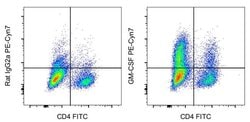Learn More
Invitrogen™ GM-CSF Monoclonal Antibody (MP1-22E9), PE-Cyanine7, eBioscience™
Rat Monoclonal Antibody
Supplier: Invitrogen™ 25733182

Description
Description: The MP1-22E9 antibody reacts with mouse granulocyte/macrophage - colony stimulating factor (GM-CSF). The MP1-22E9 antibody is a neutralizing antibody. mouse GM-CSF is a 14 kDa factor produced mainly by activated T cells and macrophages. Other cell types, such as endothelium and fibroblasts, also secrete GM-CSF in response to TNF-alpha, IL-2, IL-1, and IFN-gamma. GM-CSF stimulates growth of macrophages, granulocytes and dendritic cells. GM-CSF is found as a membrane-bound form and also as a complex associated with the extracellular matrix. Non-glycosylated GM-CSF is biologically active. Applications Reported: This MP1-22E9 antibody has been reported for use in intracellular staining followed by flow cytometric analysis. Applications Tested: This MP1-22E9 antibody has been tested by intracellular staining followed by flow cytometric analysis of restimulated mouse splenocytes. This may be used at less than or equal to 0.25 μg per test. A test is defined as the amount (μg) of antibody that will stain a cell sample in a final volume of 100 μL. Cell number should be determined empirically but can range from 10^5 to 10^8 cells/test. It is recommended that the antibody be carefully titrated for optimal performance in the assay of interest. Light sensitivity: This tandem dye is sensitive to photo-induced oxidation. Please protect this vial and stained samples from light. Fixation: Samples can be stored in IC Fixation Buffer (Product # 00-8222-49) (100 μL of...
The GM-CSF gene encodes for a cytokine that regulates the production, differentiation, and function of macrophages and granulocytes. The active form of the protein exists as a homodimer in the extracellular space. This gene is located in a cluster of related genes at the chromosome region 5q31, which has been associated with interstitial deletions in the 5q- syndrome and acute myelogenous leukemia. Other genes in the cluster include interleukins 4, 5, and 13. The gene is involved in promoting tissue inflammation. Elevated levels of cytokines, including the one produced by this gene, have been observed in SARS-CoV-2 infected patients with acute respiratory distress syndrome. Mice that lack this gene or its receptor have been shown to develop pulmonary alveolar proteinosis.
Specifications
| GM-CSF | |
| Monoclonal | |
| 0.2 mg/mL | |
| PBS with 0.09% sodium azide; pH 7.2 | |
| P01587 | |
| CSF2 | |
| Affinity chromatography | |
| RUO | |
| 12981 | |
| 4°C, store in dark, DO NOT FREEZE! | |
| Liquid |
| Flow Cytometry | |
| MP1-22E9 | |
| PE-Cyanine7 | |
| CSF2 | |
| colony stimulating factor 2; colony stimulating factor 2 (granulocyte-macrophage); colony-stimulating factor; CSF; CSF2; Csfgm; cytokine; GMCSF; Gm-CSf; granulocyte macrophage colony stimulating factor; granulocyte macrophage-colony stimulating factor; granulocyte-macrophage colony stimulating factor 2; granulocyte-macrophage colony-stimulating factor; MGC131935; MGC138897; MGC151255; MGC151257; MGI-IGM; M-GM-CSF; molgramostin; put. GM-CSF; sargramostim | |
| Rat | |
| 100 μg | |
| Primary | |
| Mouse | |
| Antibody | |
| IgG2a κ |
The Fisher Scientific Encompass Program offers items which are not part of our distribution portfolio. These products typically do not have pictures or detailed descriptions. However, we are committed to improving your shopping experience. Please use the form below to provide feedback related to the content on this product.

